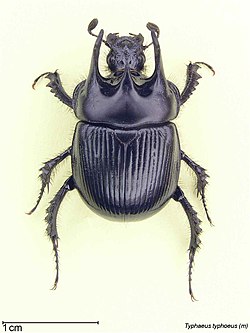| Typhaeus typhoeus | |
|---|---|
 | |
| Typhaeus typhoeus male | |
| Scientific classification | |
| Kingdom: | |
| Phylum: | |
| Class: | |
| Order: | |
| Suborder: | |
| Family: | |
| Genus: | |
| Species: | T. typhoeus |
| Binomial name | |
| Typhaeus typhoeus | |
Typhaeus typhoeus, or the minotaur beetle, is a beetle in the family Geotrupidae, also referred to as earth-boring dung beetles. They are native to Europe. [2] [3] The beetle is named after the Typhon, a giant of Greek mythology.
